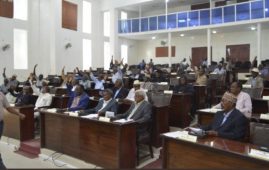(By Jacey Fortin)
If you’re in Africa and want to get a good look at the reaches of outer space, you’d be hard-pressed to find a better vantage point than the top of Entoto, a mountain on the outskirts of Ethiopia’s capital city of Addis Ababa. Up there, 10,499 feet (3,200 meters) above sea level, the air is thin and cloud cover is minimal for most of the year. Stargazers’ annoyances — tall buildings, street lamps and bright car headlights — are virtually nonexistent.
It’s prime real estate for the Ethiopian Space Science Society, which is building an observatory on Entoto that will feature two massive optical telescopes. The project will bring this East African country one step closer to developing a formal space program.
Thursday marked the installation of a silver dome that will house one of the two telescopes. A towering crane hoisted the dome from the ground, and workers secured it atop a small concrete building. The cavity where the telescope is meant to sit remains empty — but not for long. Scientists at the facility expect both telescopes to be delivered and begin functioning within a matter of weeks.

Once that happens, students and researchers will be able to use the Entoto telescopes to observe astronomical objects in space, explained Tulu Besha, the facility’s head of earth observation.
“The telescopes’ application nowadays is very wide,” he added. “Once we establish this facility and create post-graduate programs in space sciences, our students will be able to go anywhere and participate in international satellite communication missions. They will get good skills and can work to benefit other types of technology too, like telecommunications.”
When it comes to space programs, Ethiopia is light years away from some of Africa’s pioneers — most notably Nigeria, which has sent several satellites into orbit; and South Africa, whose national space agency has become a hub for African space sciences. But here on Entoto, the attitude isn’t one of competition but of collaboration; there’s no question that the facilities here don’t yet measure up to established international observatories. The telescopes’ main purpose will be to set the stage for astronomical education here in Ethiopia, and post-graduate students who use the observatory will be encouraged to study abroad, Laboratory Director Solomon Belay told International Business Times. But having been one of the founding members of the ESSS, he’s proud of how far the facility has come.
“ESSS began when I was a graduate student; a group of us started a stargazing program using small telescopes on the mountain,” he said. “Ethiopia’s climate conditions are perfect for astronomy, and that is a good base for the development of other sciences and technologies. So we wanted to encourage people here to work in space sciences.”
The ESSS was formally inaugurated in 2004. It has four main goals: developing the necessary infrastructure for scientific research, promoting international collaboration, conducting outreach and promotion of the sciences within Ethiopia, and putting pressure on the government to include space sciences in school curriculums.
The Entoto facility began construction in 2008, and it’s far from finished. Just down the hill from the telescope site, a long building meant to house the main laboratories and meeting rooms still lacks most of the necessary equipment. But the telescope installations will be a huge step forward, especially once they’re outfitted with telecommunications technology allowing them to be controlled from afar.
None of this will be cheap. The telescopes and their accessories alone — supplied by Astelco Systems, a German company — cost $3.4 million. Funding for this project has been tricky in a country where more than one-fourth the population lives below the poverty line, and where national savings have hit a dangerous low point after years of heavy public spending.
The Ethiopian government funds the project indirectly via the 32 public universities that will run the observatory; it also provides some of the necessary infrastructure including roads, electricity and internet connectivity. But most of the money for the lab’s construction and equipment is coming from individual members of the ESSS — an organization of more than 1,800 people — and no one has contributed more than board member Sheikh Mohammed al Amoudi, a Saudi-Ethiopian billionaire businessman who’s ranked by Forbes as the world’s 65th-richest person.
If it weren’t for that largesse, space sciences might be prohibitively expensive for a developing country like Ethiopia — but the researchers and students who will use the telescopes at Entoto see it as a wise investment.
“The far-sighted future plan is that maybe after a long time, our profession will grow and we’ll launch satellites — or people — into space,” Solomon said. “But we really want to help Ethiopian development and contribute to the fast-growing economy by using the scientific approach, as well as facilitating knowledge and technology transfers. This is the first priority for us.”
**********
*Originally published at InternationalBusinessTimes, Oct. 25, 2013, “A Space Program For Ethiopia? Two Telescopes Have Students, Astronomers Seeing Stars”, authored by Jacey Fortin.






1 Comment on this post
Comments are closed.
Leave a Comment